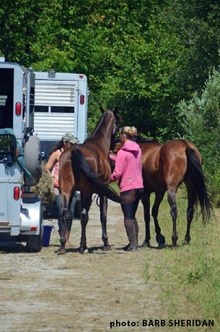Youâre committed. You took the plunge. You have bought your first show horse and are now ready to reach your goals together. The trailer you currently have suited your other horse just fine, but what about this new guy?

Different horses - Different trailer considerations
For many horses, loading and unloading is the most stressful part of trailering making this a central consideration when you buy your new trailer.
© 2015 by Barbara Sheridan
What if he has never loaded into a slant-load trailer or used a ramp to get in? USRider takes a look at some of the important questions you should consider when purchasing a new trailer.
Almost everyone has come across a horse that does not willingly load into a trailer. For a lot of horses, loading and unloading is the most stressful part of trailering. Making this a central consideration when you buy your new trailer can be imperative for your horse. Some trailer features can make a big difference when it comes to the ease of loading and unloading.
Food for thought (or comfort): Will your new horse travel calmly and comfortably in a slant- or straight-load trailer? A two-horse straight-load trailer is fairly uncommon these days. A slant-load trailer is a more âmodernâ buy.
However, if you have a horse that has been loading into a straight-load trailer his whole life, you may run into a few barriers (and headaches) if you settle on a slant-load trailer. In many slant-load trailers, horses can be turned around inside and be led out, easing some of those unloading fears.
Three- and four-horse slant-load trailers with a large tack room at the front are the most popular among recreational and competing riders. However, if the horse in the front stall has a problem, all horses must be unloaded to get to that horse unless you have an emergency side door.
When looking into the purchase of a two-horse straight-load trailer, consider the size of your horse. For example, if you have a large Irish Sport Horse, a straight-load may be a poor choice because it will make for a tight squeeze.
If you have a smaller breed, like a Quarter Horse, he will fit comfortably and experience less stress. However, a straight-load trailer allows for more neck room and also allows for each horse to be unloaded without disturbing the other.
With that said, there are arguments that a straight-load trailer is better for a larger horse as he is able to stretch out more. You be the judge. Sometimes going as far as measuring can be a big help!
So which is better suited for your new companion? Opinions vary when it comes to the experts. A few companies including Sundowner, Featherlite, Hart and CM Trailers offer both designs; however, many customers prefer the slant load.
There are some arguments that a straight-load is better for your horse as he does not have to balance at a slant and allows him to use both front and hind feet evenly when loading and unloading. Ramps can solve problems if your horse is not comfortable stepping up into a trailer.
There is a big difference in two-and three-horse trailers as far as hauling preferences. A two-horse bumper-pull trailer is much more stable than a three-horse bumper-pull. If youâre committed to a three-horse trailer, it is highly recommended by experts that you choose a gooseneck style as it creates better stability for handling that amount of weight.
A few creature comforts to consider: Windows within reach. Trailers are generally very tall with some window and door latches hard to reach. Some companies, such as Sundowner have moved these latches to the bottom or their drop down windows for better accessibility.
When looking for your new trailer, make sure to check how each door locks. Many door handles will have deadbolt locks. This can be a big problem when you are fiddling with a key while trying to get to a distressed horse inside. Deadbolts should only be seen on tack and dressing rooms.
Make sure your trailer is welcoming. The larger the windows and vents the better; along with inviting interiors, such as dividers that swing to the side and removable rear posts. They appear more open and roomy to a horse and not like they are walking into a cave where something is waiting to eat them.
One last note: Make sure there is good lighting inside your trailer for your horse(s). This is especially important if you are traveling at night and have to stop and unload your horses to stretch their legs. Loading them back in the trailer may become a headache if you do not have lights.
About USRider
USRider â in its 14th year of operation â is the only company to provide emergency roadside assistance for horse owners. Through the Equestrian Motor Plan, USRider provides nationwide roadside assistance and towing services along with other travel-related benefits to its Members.
The plan includes standard features such as flat-tire repair, battery assistance, lockout services, and roadside repairs for two vehicles and trailers with horses, plus towing up to 100 miles. As an additional service, USRider maintains a national database that includes emergency stabling, veterinary and farrier referrals.
For more information about the USRider Equestrian Motor Plan, visit www.usrider.org online or call (800) 844-1409. For additional safety and travel tips, visit the Equine Travel Safety Area on the USRider website at www.usrider.org.
By: Lindsey K. Mulvany
